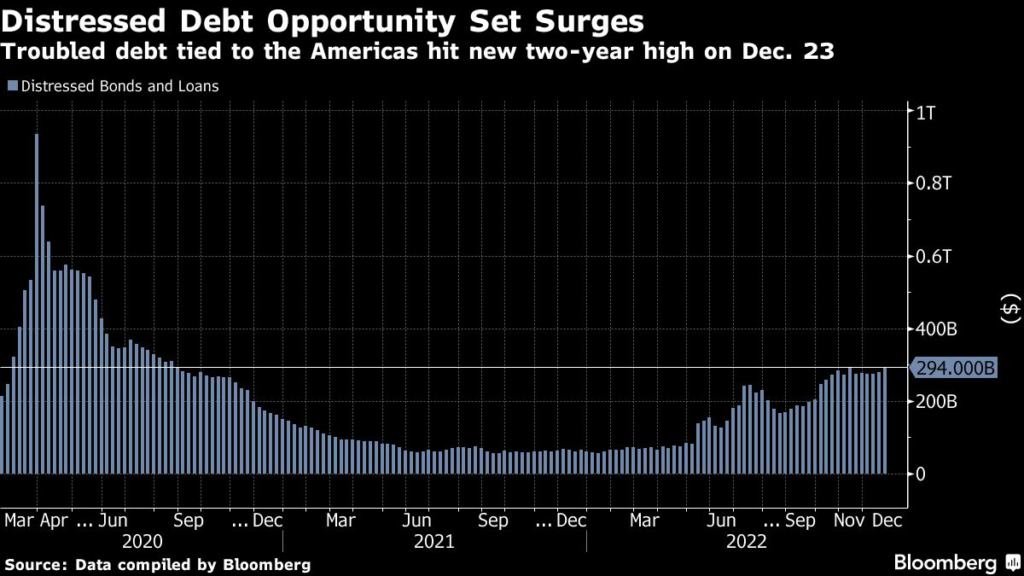Savvy investors seized tightening credit markets this year to reshape the distressed investing playing field just as more companies look destined for default in 2023.
(Bloomberg) — Savvy investors seized tightening credit markets this year to reshape the distressed investing playing field just as more companies look destined for default in 2023.
Trouble hit U.S. corporate earnings, pressured by rising prices and shrinking margins, and some companies that began the year flying high found themselves stuck in quagmires of debt. The saga of Twitter Inc., for instance, exemplified the arc of credit markets in 2022, and Carvana Co. similarly went from tech darling to disaster in just a matter of months.
Creditor culture also took a turn as top investors seemed to reconsider the aggressive maneuvers characterizing so many recent corporate bailouts. All the while, a dubious source of opportunity bloomed in Europe, as wartime sanctions against Russia sent corporate and government assets there plunging and helped contribute to a surge in global distressed debt.
The pile of distressed bonds and loans tied to the Americas grew to a two-year high of $294 billion on Dec. 23, and the heap is poised to keep growing. Investors looking ahead to 2023 would be wise to soak up lessons learned during a whipsaw year.
It would be easy to let some of the action slip your mind. Here, Bloomberg recaps the developments that reshaped distressed debt investing this year.
Russia
Having saved up cash for years, hedge funds were ready to pounce when missiles started flying into Kyiv in February. Wall Street banks avidly sourced declining bonds for their clients and investors poured into bets using both debt and derivatives — despite debate over the ethics of profiting from a humanitarian disaster.
Some of the derivative plays paid off almost immediately, while bondholders at the time of Russia’s sovereign debt default in June are in for a long and tangled process of sorting out their recoveries.
Twitter’s Hung Debt
The debt that Elon Musk lined up to finance his acquisition of Twitter helped crowd bank balance sheets to the tune of $43 billion near the end of the year. Interest rate hikes and inflation made it hard to unload as the typical buyers sought to avoid risk.
While some banks looked to sell the debt before the end of the financial year, others are inclined to hold until markets improve. For the banks, both options sting, and will affect their approach to risky lending next year, said Jamie Weinstein, portfolio manager and head of corporate special situations at Pacific Investment Management Co.
“Banks that are absorbing losses on hung debt are less likely and less willing to make new financing commitments,” Weinstein said — meaning troubled companies may be shut out of the market altogether.
Crypto Crash
Though the wave of distress among crypto firms involved little liquid debt, it still sent the restructuring industry aflutter.
For lawyers and advisers, it was race to master new subject matter in time to capture business. For investors, it served as a warning about just how fast asset values can disappear once the first domino falls.
A spate of crypto companies sought bankruptcy protection this year as slumping token prices triggered a cascade of distress and exposed a web of interdependence within the industry. When Sam Bankman-Fried’s FTX exchange filed for bankruptcy in November, the move soon forced lender BlockFi Inc. to follow suit. Voyager Digital earlier attributed its July bankruptcy to the failure of crypto hedge fund Three Arrows Capital, and crypto miner Core Scientific in a Dec. 21 bankruptcy filing cited as a cause the July bankruptcy of Celsius, one of its largest hosting customers.
New Rules
Ongoing litigation tied to long-standing disputes over aggressive distressed financing maneuvers delivered potential wins for the underdogs.
A New York state judge gave life to claims from a group of lenders alleging that clothing company Boardriders Inc. breached contracts when it got new funding from Oaktree Capital Management and others. Judge Andrea Masley declined a request to dismiss the claims, suggesting they may have to have some merit.
That and a similar decision in a case regarding mattress seller Serta Simmons may have a chilling effect on the exploitation of loose debt terms that benefits some investors at the expense of others. Though each situation is unique, these decisions cast some doubt on the legality of such maneuvers.
The rulings “have had an impact on how people are thinking about this on all sides,” said Pimco’s Weinstein. “Whatever the playbook was before, some people are thinking that maybe it needs to be different.”
Carvana & Cooperation
Accordingly, camaraderie seemed to come into style as some lender groups instead banded together and pledged to negotiate as a whole with company management.
Such was the choice of holders of nearly $4 billion of Carvana Co.’s debt. A group led by Apollo Global Management Inc. and Pimco signed a pact designed to avoid the kind of fights that sometimes drag out in court.
“You essentially are locking arms with your co-holders and saying, ‘we’re not going to do anything that isn’t available to the rest of the group,’” said Damian Schaible, co-head of restructuring at law firm Davis Polk & Wardwell.
The fallout from financing deals at companies like Envision Healthcare Corp. and Incora — where favored lenders helped shift assets away from creditors — has lent appeal to the concept of creditor cooperation.
“You haven’t heard about them much at all for the last several years,” Schaible said, “but debt investors have started reverting to considering co-op agreements to protect themselves from this new threat of a private equity sponsor working with 51% of lenders to do something terrible to the other 49%.”
More stories like this are available on bloomberg.com
©2022 Bloomberg L.P.










